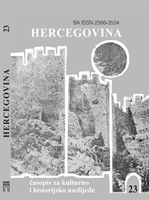UZURPACIJA VAKUFA BABA BEŠIROVE DŽAMIJE NA BALINOVCU U MOSTARU: BISKUP FRA PAŠKAL BUCONJIĆ I SLUČAJ „MALI HAREM“
THE USURPATION OF THE BABA BEŠIR MOSQUE WAQF IN BALINOVAC, MOSTAR: BISHOP FRA PAŠKAL BUCONJIĆ AND THE “MALI HAREM” CASE
Author(s): Mehmed HodžićSubject(s): Cultural history, Museology & Heritage Studies, Architecture, Social history, 19th Century, Pre-WW I & WW I (1900 -1919), Sociology of Art, History of Art
Published by: Fakultet humanističkih nauka, Univerzitet »Džemal Bijedić« u Mostaru
Keywords: Mostar; endowment; Baba Bešir’s mosque; Balinovac; bishop Buconjić; Zahum; harem; usurpation;
Summary/Abstract: This paper presents the case of the usurpation of waqf property in the Baba Bešir district of Mostar at the beginning of the twentieth century. Based on unpublished archival material, it depicts how the waqf plot known as “Mali Harem”(eng. “Small Harem”) or “Harem u strani” (eng. “Side Harem”) was unlawfully appropriated by Mostar’s bishop, Fra Paškal Buconjić (1834- 1910), and the measures taken by the District Waqf-Mearif Commission in Mostar and the central waqf administration to return this cemetery to waqf possession. In the Memorandum sent by representatives of Bosnian Muslims to Minister Kallay in 1900, alongside numerous other instances of waqf property usurpation and devastation in Bosnia and Herzegovina, it was stated that in Mostar, Bishop Buconjić had made a garden on a Muslim cemetery. Literature has often repeated this information without providing detailed accounts of how this usurpation occurred. For this reason, we aimed to ascertain whether archival materials could reveal how “Mali Harem” came into private ownership at the start of the twentieth century. The report on waqf possessions and properties from 1931 listed this cemetery as part of the waqf, suggesting that a process had been undertaken in preceding years to return it. By analyzing information from the archives, we determined that Bishop Buconjić was unwilling to voluntarily relinquish this property and return it to waqf ownership, claiming he had purchased it, though he did not know from whom. By selling this property to Marijan Zlomislić, he further complicated the restitution process. This process also highlights and presents the role of the Austro-Hungarian authorities in Mostar in their treatment of specifically Muslim institutions such as waqfs. This paper, by analyzing and reconstructing the fate of “Mali Harem,” aims to contribute to the understanding and study of the history of Mostar’s waqfs, as well as Mostar in general.
Journal: Hercegovina
- Issue Year: 2024
- Issue No: 23
- Page Range: 105-125
- Page Count: 21
- Language: Bosnian

